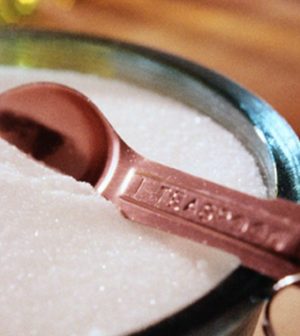- Navigating Your Midlife Crisis: Embracing New Possibilities
- City Raccoons Showing Signs of Domestication
- Mapping the Exposome: Science Broadens Focus to Environmental Disease Triggers
- One Week Less on Social Media Linked to Better Mental Health
- Your Brain Changes in Stages as You Age, Study Finds
- Some Suicide Victims Show No Typical Warning Signs, Study Finds
- ByHeart Formula Faces Lawsuits After Babies Sickened With Botulism
- Switch to Vegan Diet Could Cut Your Greenhouse Gas Emissions in Half
- Regular Bedtime Does Wonders for Blood Pressure
- Dining Alone Could Mean Worse Nutrition for Seniors
How to Cut Your Kids’ Sugar Intake

The concerns about sugar and kids go far beyond the risk of cavities.
An extensive research review by the American Heart Association (AHA) found that kids who consume a lot of foods and drinks with added sugar could develop heart disease risk factors — like obesity and high cholesterol — starting in childhood.
These risks can occur with sugar intake far lower than a typical child’s. In response to this threat, AHA issued strong recommendations to safeguard kids’ health.
First, children under 2 years old shouldn’t be given any added sugars. That means no packaged food of any kind that lists any type of sugar among the ingredients. The natural sugars in whole foods like fruit, for instance, are fine. Next, kids between ages 2 and 18 should take in less than 25 grams of added sugar daily.
Doing the Math on Family Sugar Limits
- For kids and women: 25 grams equals 6 teaspoons equals 100 calories or about 5 percent of daily calorie intake.
- For men: 37 grams equals 9 teaspoons equals 150 calories or about 5 percent of daily calorie intake.
Compare these numbers to the 80 grams of sugar most kids eat every day. That’s more than triple the suggested limit.
What can you do to cut back? Nutrition labels list sugar in grams, so it’s easy to keep track of daily intake. Because sweetened beverages pose a particular threat, kids and teens should be limited to just one 8-ounce serving per week.
Another significant source of sugar is breakfast cereal. One serving of some brands has half or more of the daily limit, about as much as two cookies. Granola sounds good, but can be just as sugar-filled, whether in cereal or bar form. Plain puffed rice, corn flakes and hot cereals you make from plain whole grains, like rolled oats and grits, are healthier. Consider them to start the day heart smart.
More information
The American Heart Association has more on kids and sugar limits, including tips to make diet changes.
Source: HealthDay
Copyright © 2025 HealthDay. All rights reserved.










